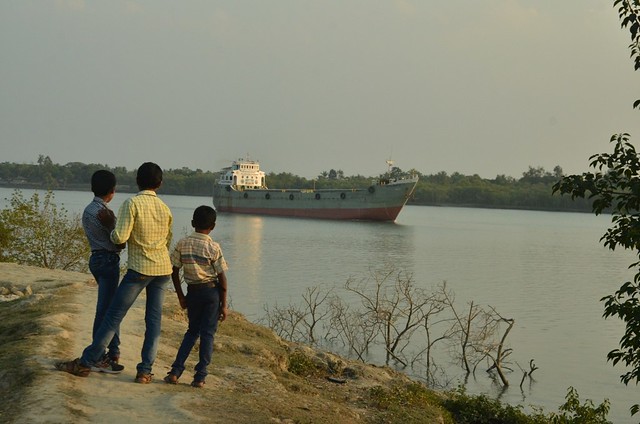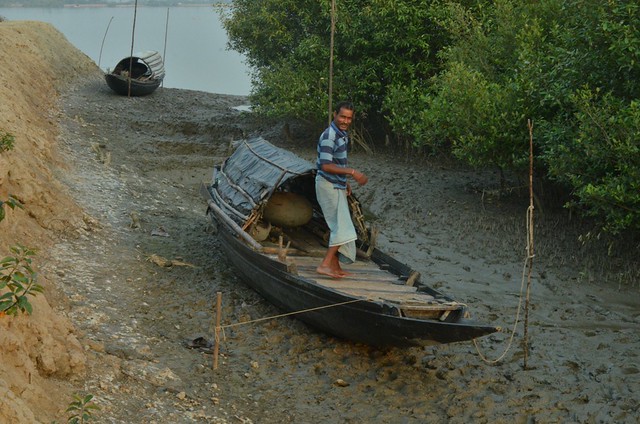In the second of the four-part series, we look at how the livelihoods of the fishing community is increasingly under threat to overfishing, change in climate and the unquestioned powers of the forest officials.
By Amit Kumar, Twocircles.net
Sunderbans: The Public Hearing had made it clear that due to the lack of effectiveness in implementing the Forest Rights Act, issues that now threaten the livelihoods of the people go much beyond the implementation of one, or a few, Acts. Over the past two decades, the very existence of these islands, and its people, has been under increasing threat and man-made laws seem ill equipped to help local people find ways of sustenance.
Rajni Mandal, a member of the audience in the Public Hearing had been listening with apt attention, and towards the end of the meeting, approached me. After questioning me about why I was here, he said something which seemed surprising initially. “I do not understand the point of holding the meeting in this school,” he said, before clarifying, “Hardly anyone from this island, or Rangabelia village (on the main island of Gosaba) go fishing. If you want to talk to people, come to my village, almost everyone is either a fisherman or a honey collector. If they had held this meeting in the interior islands, it would have benefited a lot more people,” he said.
We would have to take another boat, he said, to go to his village, Chotto Molla Khali. Mandal, who is also a fisherman, was in his 30s and had been fishing for the past 15 years. He said he preferred crabs over fish, for they fetched more in the market. The boat ride was short: his village had been on the same island as Uttar Danga, but on the opposite side: from this village, one could see the site of probably the Left Regime’s worst atrocity: the island, and the massacre, of Marichjhapi.
While approaching Chotto Molla Khali, Mandal explained his situation. Yes, the situation with Forest Officials had worsened, but his concerns were far more serious. “There is no fish,” he says.
What?
“There is fish, yes, but we are running out of places to find them,” he says.
Why?
As we walked through bone-dry land with remnants of what seemed like a good paddy harvest, Rajni asked other men from his village to join in.
Simanta Mandal, a 27-year-old fisherman, showed us his recent catch: a cast of crabs which would sell for Rs 400 a kilo in the market. On first impressions, it seemed a nice catch for what he described as a “two-week” incursion into the maze of rivers. That is, until he broke down the numbers over twenty minutes.
Not everyone can go fishing in Sunderbans. Not even locals, who have been living here all their lives. It is another matter that even if you do venture around the islands, you will land zero fish (because as Mandal said, there aren’t any fish).
The licence to fish, the permission to exploit
Of the 4.2 million people in Sunderbans, almost 90% are from the Paundra Kshtriya, Namasudra, and Jele castes from the Schedule Caste Community. In the late 19th and 20th century, according to various studies, Paundras and Namasudras migrated to the forests during the time when the British government was converting large tracts of mangroves to agricultural land. A number of people in Sunderbans, including Rajni Mandal, trace their roots to Jharkhand. Among the population, almost 80%, or three million, depend on fishing for a source of livelihood.
But the number of Boat Licensing Certificates, which gives you the Right to fish in Sunderban waters, stands at 923. Yes, for a population of roughly 3 million, there are 923 licenses, of which only 700 or so remain active. The other license owners either died, or left the profession. The licenses were issued in 1973, for the Sundarban Tiger Reserve area of 892.38 square kilometers.
“What has happened since,” Simanta spoke after explaining the concept of BLC, “is that all fishermen rent these BLCs for anything between Rs 20,000-30,000 per annum, depending on the time of the year and the catch they expect. I too rented this for around Rs 25,000 for the year.” Importantly, while the license belongs to one person, there can of course be more people on the boat, since it is a collective effort. Simanta last went out to fish with three other men, so his collection had also been split accordingly. “Then, there is the cost of going to fish. We take loans from Arakdar (merchants), who charge no interest on the loan. Instead, we either pay them off slowly, or as is mostly the case now, they buy our catch at about 25% lower than the market rate,” Simanta adds. This, he added, is done until the loan is paid off.
“It is more than 30% lower than the market price,” another fisherman added. Others, however, agreed that it was “not a bad deal” in order to go fishing. It seemed like the only viable option too, given that none of the fishermen we spoke to had ever approached a bank for a loan.
 “ While big cargo ships like these, on their way to Bangladesh, can use this route, local fishermen are not allowed to use machine-powered boats
“ While big cargo ships like these, on their way to Bangladesh, can use this route, local fishermen are not allowed to use machine-powered boats “So,” Simanta continued, “after all these calculations, I made about Rs 4,500 from this trip,” he says. “But do you know how long do we have to row for this catch?” he asked.
Why couldn’t they use mechanised boats? Was it because of monetary constraints?
“No,” Rajni Mandal added, reminding me again of what Younus Mulla said. “We cannot take mechanized boats for fishing, it causes pollution,” he said. This seemed a bit odd, for we had seen cargo ships heading towards Bangladesh on our way. “Cargo boats, cruise ships, tourist boats are allowed to use diesel-powered boats, except fishermen. We have to row,” he said. “Upto six hours to enter the area of fishing,” Simanta added.
 ” Niranjan Sarkar, one of the local fishermen, shows some of his recent catch
” Niranjan Sarkar, one of the local fishermen, shows some of his recent catch What was defined as the area of fishing? That again, is a complex issue when it comes to Sunderbans.
The Sundarban Tiger Reserve (STR) is spread over 2, 585 sq. kms. Of this, about 1,600 square kms is land area and the rest 985 km is the water area. The first Sundarbans Management Plan demarcated the STR into the wilderness zone or Core Area measuring 1,330.10 square km. No activities like fishing or honey collection was permitted here. The remaining area, in the north and the east of the Core Area, was defined as the 1,254.9 square kilometer buffer zone, wherein all activities that forest dependent communities engage with were permitted. In 1977, the forest department expanded the no fishing zone by 437.61 square kilometers, notifying Sajnakheli Bird Sanctuary, to about 1,692 square kms. Within the STR, in 2007, the State Government expanded the area by around 1,700 square kilometers.
Essentially, what this has meant is that not only has the fishing area come down, it has also presented the fishermen with challenges they cannot simply cope with. “Unlike land, you cannot divide water. A number of our fishing routes have been blocked and we have to now go to new places to fish, where the Forest Officials are only too happy to take their share,” says Simanta. The increase in reserve forest area, the increase in fishing due to multiple rentals of the same old BLCs and the recent changes in weather due to global warming have meant that the fishermen of Sunderbans, despite living around water, are now entering unchartered territories for fishing. “We often end up fishing close to the waters around the Indo-Bangladesh border. In a few years, we will be going to the sea to fish,” added Rajni. The waters near the border present another challenge: Pirates. However, according to the fishermen, the incidents of Pirate attacks have come down in the last five years due to the increased patrolling around the border areas. “But who is scared of pirates when there are Forest Officials around,” Simanta adds laughingly.
 “ A fisherman on his boat
“ A fisherman on his boat But what about Tigers: the most famous enemy of the fishermen?
“The last time we spotted a Tiger on this island was in 2009, a couple of months after Cyclone Aila. Now the Tiger is not so much an issue, at least on this island,” Simanta said. All reserve islands had been sort of wrapped in a two-layer netting, to ensure that neither humans enter the reserve islands nor do the tigers encroach out of the territory. “Tigers and humans can live; they have done so in the past too. It is the other humans (forest officials) we are scared of,” added another fisherman.

